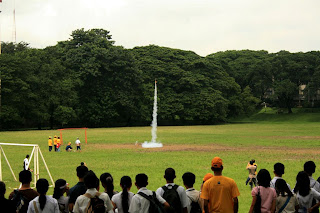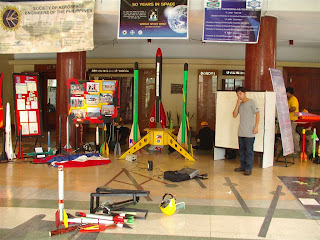The first amateur rocket fabricated in the Philippine State College of Aeronautics, Villamor Air Base Campus, Pasay City was made by third year BS Aeronautical engineering students who are now Aeronautical Engineers Napoleon Reyes, Amiel Duke Legaspi and Jay-R Basitao, with aircraft maintenance technology student John Derrick Mesa and avionics student Jadiel Lambino during the Academic Year 2005-2006 under the supervision of their instructor, Engr. Cielito Robles. They involved themselves from purchasing the raw materials, to cutting, to assembling and up to the painting and finishing touches of four (4) amateur rockets. They applied “theory into practice”. They applied their knowledge in rocket propulsion system, aerodynamics, avionics and structural analysis in building the first rocket in PhilSCA. They had to use acceptable methods and practices in aviation like using the proper tools, using the tools in a proper way, carefully measuring the materials before cutting and solving the problems and difficulties encountered throughout the process. This gave the students a feel of being a technician in the aircraft industry, though at a much smaller scale.
During the celebration of the World Space Week with the theme “50 Years in Space” the Space International Association featured the five-foot “PhilSCA Amateur Rocket Project” called Kuwitis 1 made by the PhilSCA students. It was primarily made of circular cardboard from the spool of chip snacks packaging material. The fin which provide stability of the rocket are made of balsa wood appropriate for amateur rocket component. The non-metallic parts of the Kwitis 1 are preferred as there is a regulation that limits the amount of metal to be used in amateur rocket construction.
The study behind propulsion may be simplified by
The study of the students in the principles of Rocket Propulsion, particularly in reaction and formulas reflected that the force that drives a rocket is essentially the same reaction force in the discussion of turbojet engine theory for aircraft. The principal difference between a turbo-jet and rocket engine is the former requires oxygen from the atmosphere in order to burn its fuel while the latter carriers its own supply of oxygen or other oxidizer. This is why rocket engin8es are used for space travel.
In the liquid fuel, an oxidizer is fed into a chamber and burned. An opening at the one end of the chamber allows the expanded gases to escape, thus producing thrust in accordance with
Where:
F = force, psi
Pc = pressure in the chamber, psi
At = area of the throat, sq.in.
The rocket thrust, however, is not the result of the rocket exhaust pushing against the air outside the rocket engine. The thrust will be the same regardless whether the reaction takes place in the atmosphere or in a vacuum. This makes rocket as the only suitable power plant for space vehicles.
In the construction of an amateur rocket, however, the rocket engine to be used must be cautiously selected. There are two main categories of rocket engines: (a) liquid rockets and (b) solid rockets. In a liquid rocket, the propellants, the fuel and the oxidizer are stored separately as liquids and are pumped into the combustion chamber of the nozzle where burning occurs. In a solid rocket, the propellants are mixed together and packed into a solid cylinder. Under normal temperature conditions, the propellants do not burn. They will only burn when exposed to a source of heat provided by an igniter.
Once the burning starts, it proceeds until the propellant is exhausted. With a liquid rocket, one can stop the thrust by turning off the flow of propellants. In a solid rocket, the casing has to be destroyed to stop the engine. Liquid rockets tend to be heavier and more complex because of the pumps and storage tanks. The propellants are loaded into the rocket just before launch. A solid rocket is much easier to handle and can sit for years before firing.
A rocket is basically composed of an airframe, fins, propellant and a nosecone. The airframe serves as the housing of the rocket. The fins provides stability and control of the rocket. The propellant sustains the thrust or force of the rocket. The nose cone is responsible for the streamlining of the rocket in flight.
The nose cone of the rocket must be constructed in such a way that it blends with the center of gravity and center pressure of the rocket. This study, however, focused on the material used in the construction of the nose cone and its effect on the flight direction and altitude of the amateur rocket.

